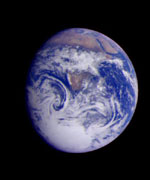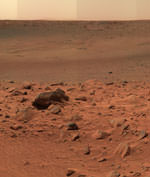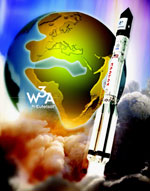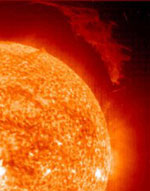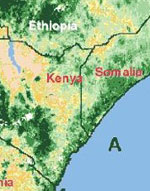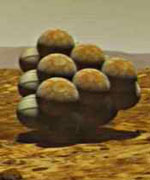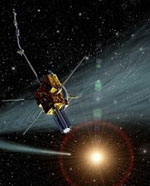
Image credit: NASA
Deep space is cold. Very cold. That’s a problem–especially if you’re flying in an old spaceship. And your power supplies are waning. And the fuel lines could freeze at any moment. Oh, and by the way, you’ve got to keep flying for thirteen more years.
It sounds like a science fiction thriller, but this is really happening to the NASA/European Space Agency spacecraft Ulysses.
Ulysses was launched in 1990 on a five-year mission to study the sun. The craft gathered new data about the speed and direction of the solar wind. It discovered the 3D shape of the sun’s magnetic field. It recorded solar flares on the sun, and super-solar flares from distant neutron stars. Ulysses even flew through the tail of comet Hyakutake, an unexpected encounter that delighted astronomers.
The mission was supposed to end in 1995, but Ulysses was too successful to quit. NASA and the ESA have granted three extensions, most recently in Feb. 2004. Ulysses is scheduled to keep going until 2008, thirteen years longer than originally planned.
Ulysses’ extended mission, as before, is to study the sun. But at the moment Ulysses is far from our star. It’s having an encounter with Jupiter, studying the giant planet and its magnetic field. Sunlight out there is 25 times less intense than what we experience on Earth, and Ulysses is getting perilously cold.
Back in the 1980’s, when Ulysses was still on Earth and being assembled, mission planners knew that the spacecraft would have to endure some low temperatures. So they put dozens of heaters onboard, all powered by a Radioisotope Thermoelectric Generator, or “RTG.” These heaters have kept Ulysses comfortably warm.
But there’s a problem: the RTG is fading.
“The power output of the RTG has been dropping since the spacecraft was launched,” says Nigel Angold, the Ulysses ESA Spacecraft Operations Manager at JPL. RTG power naturally fades as its radioactive source decays. That’s as expected. What planners didn’t expect was 13 years of extra operations.
“When Ulysses was launched in 1990 the RTG produced 285 watts. Now it’s down to 207 watts–barely enough power to run the science instruments and the heaters at the same time,” notes Angold.
Inside Ulysses the temperature varies from place to place. “Many of the science instruments are already below freezing (0 C),” says Ulysses thermal engineer Fernando Castro. “That’s OK, because they can operate at low temperature.” But the fuel lines are another matter. They’re hovering about 3 degrees above zero, “and if they freeze we’re in trouble.”
Fuel lines are critical to the mission. They deliver hydrazine propellant to the ship’s eight thrusters. Every week or so, ground controllers fire the thrusters to keep Ulysses’ radio antenna pointing toward Earth. The thrusters won’t work if the hydrazine freezes. No thrusters means no communication. The mission would be lost.
About eight meters of fuel line snake through the spaceship. Every twist and turn is a possible cold spot, a place where the hydrazine can begin to solidify. “If the hydrazine freezes anywhere, I don’t know if we can safely thaw it again,” worries Castro. When hydrazine thaws, it expands, possibly enough to rupture the fuel lines. Ulysses’ propellant would fizzle uselessly into space.
The temperature at any given point along the fuel lines is bewilderingly sensitive to what’s going on elsewhere in the spacecraft. Turning on a scientific instrument “here” might cause a chill “over there,” because it takes power away from one of the heaters. Firing a thruster, playing back or recording data: almost anything could upset Ulysses’ delicate thermal balance.
Above: The complicated interior of Ulysses. Dark blocks are science instruments and other devices. Fuel lines, denoted by red, blue and green, lead from a central hydrazine tank to the thrusters. Click here to view areas most vulnerable to freezing.
Even the simple act of sending the spacecraft a message can cause problems. Systems engineer Andy McGarry recalls, “last month we were sending some new commands to Ulysses when the temperature began to drop, as much as 0.8 degrees C near the fuel lines. We were less than a degree from the freezing point of hydrazine–too close for comfort.”
Engineers quickly figured out the problem. “All of Ulysses’ science instruments had been activated to study Jupiter,” explains McGarry, “and this was straining the RTG to its limit.” Ulysses would have trouble supporting even one more device. But when a signal arrived from Earth, another device did turn on, automatically: the decoder, which translates radio signals into a stream of binary ones and zeros understood by Ulysses’ computers. “The decoder was stealing power from the heaters.”
Since then ground controllers have learned to keep their transmissions to Ulysses brief, so the temperature can’t fall very far.
Ulysses is about to turn away from Jupiter and head back to the sun. Eventually solar heating will keep the hydrazine warm, and onboard heaters can be turned off, “but that won’t happen until 2007,” says Angold. Meanwhile, engineers at JPL keep a constant watch on the spacecraft.
Mission scientist Steve Suess at the NASA Marshall Space Flight Center believes it’s worth the effort. “The extended mission gives us a chance to learn a lot more about the sun.” Of special interest is the Solar Minimum. Solar activity waxes and wanes every 11 years, he explains. Ulysses studied the sun’s quiet phase, Solar Minimum, between 1994 and 1995. Now Ulysses gets to do it again. “The next Solar Minimum is due around 2006,” says Suess, “but it won’t be the same as before.” In 2001 the sun’s magnetic field flipped. The north pole shifted south, and vice versa. Magnetically speaking, the sun is now upside down. How will that affect Solar Minimum?
Perhaps Ulysses will find out ? if it doesn’t freeze to death first.
Original Source: NASA Science Story

